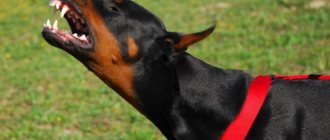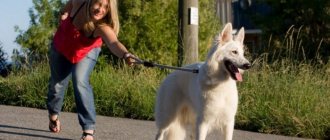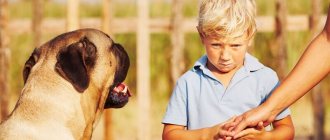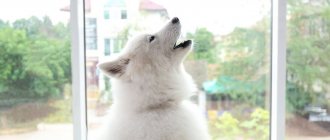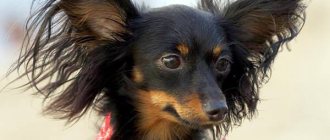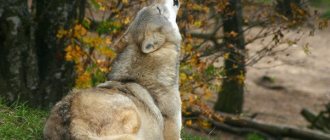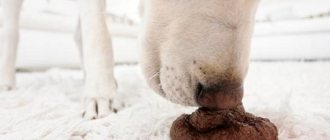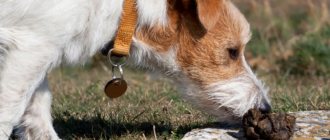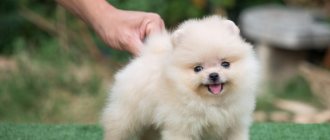Reasons why dogs may bite
Depending on the age of the dog, the reasons for the unwanted behavior may be different. A dog is a predator, with teeth and claws, and expresses its emotions and feelings with the help of its mouth and teeth.
A puppy appears in a home on average between the ages of 1.5 and 3.5 months, at which time the dog’s teeth begin to change. Changing teeth is a slow process and very painful for the puppy. The puppy tries to relieve itching and pain in the gums by tasting all surrounding objects, including the owner’s hands and clothes. At a later age, from about 6 months, when the period of puberty begins, the young dog tries to establish its place in the owner’s family, tests its strength, its position in the pack.
An adult dog may bite for a variety of reasons.:
- Fear. When a dog is afraid, the normal behavior is to try to defend itself by using its teeth. Animals, like people, have different personalities and different temperaments. In fear, for example, when receiving excessive punishment, a dog may bite, experiencing extreme stress. The survival mechanism comes into play, and the dog can seriously injure a person.
- Aggressiveness. As has already been said, all developed animals are different in character, even puppies from the same litter have very different types of temperament. Stronger individuals can show aggression, with such an animal it is necessary to start training and obedience courses earlier - if time is lost, only an experienced dog handler can help extinguish the dog’s aggressiveness.
- Pain . During illness or after an injury, when there is physical impact on a sore spot or organ, the dog instinctively tries to remove the source of pain and the only way it can achieve this is with its teeth. The stronger the pain, the stronger the bite will be. The slightest pressure and increased pain will cause the dog’s jaws to close more strongly on the limbs of the doctor or even the owner.
- Nervous disorder or overexcitement . A nervous disorder is a painful condition that can be treated with medication after consultation with a veterinarian. Overexcitation may appear after a prolonged, very active game and, having played too much, the pet does not notice that it is causing pain.
- Jealousy, desire to gain attention . A dog is a social animal and is very emotionally dependent on humans. Often, when the owner's attention is completely focused on another animal or activity, the dog tries to redirect the owner's attention to itself using its teeth.
- The desire to take possession of food . Food aggression is probably one of the most common types of aggression that many owners encounter. This behavior is absolutely natural for the animal, because nutrition is a dog’s basic instinct necessary for survival.
- Lack of education . If a dog lives in human society, it is necessary to accustom it to certain rules that apply in the community. Dog training can begin as early as 3 weeks of age. This is an ideal option, but in any case, the sooner you start teaching your puppy the rules of behavior in society, the faster he will learn and feel more confident in different situations.
Rules of behavior need to be taught to any dog, regardless of breed or size. The sooner the dog's training begins, the faster and better the dog will learn to live in human society without causing inconvenience to others.
Wrong upbringing. An incorrectly selected method of raising a dog can only worsen the situation and lead to aggression in the pet, and aggressiveness will require serious adjustments with a dog handler.
Under no circumstances should you hit a dog. Loud screams and physical violence in almost 100% of cases will lead to aggression in the pet.
Aggression from fear
Fear manifests itself in a dog in the form of various triggers. When a dog is faced with a situation that causes fear, such as excessive noise or a new object, if it feels like it can't escape or avoid conflict, your dog will feel anxious and react. If you notice your dog adopting fearful postures during play, you may be dealing with a case of fear aggression.
Guidelines to follow
The first step is to identify the stimulus that triggers the fear, such as a specific toy, your hand, a scream, or something too close. It may take some time to identify what causes the fear, but once you identify it, it will be easier for you to avoid it and gradually begin to work with the teacher.
Prevention of unacceptable behavior
The sooner you start training your puppy, the fewer problems you will have with an adult dog. The puppy absorbs all commands like a sponge, and everything that the pet learned at an early age will remain with him for the rest of his life - this applies to commands and the rules of life with a person.
You cannot treat a dog like a child or an equal. A dog, no matter how much the owner loves it, is a predator and the pet must be treated exactly like an animal. Excessive care can turn a small dog into a big monster, and a large dog into a real threat to humans and even the owner.
Common mistakes
You cannot deliberately “prank” the puppy; do not encourage him to hunt for your hands. For “hunting” use toys, dog ropes, balls.
Only positive emotions should be associated with the owner’s hands
Remember not to punish your puppy and be patient. Often, when a person does not see success in raising a puppy, he gives up. The owner returns to physical abuse or succumbs to the small animal, which will annoy the owner with a bad habit throughout, perhaps, his entire life.
If a puppy bites
The puppy does not yet realize how much power he has, and he may unknowingly bite harder than he should according to the situation. Yes, and changing teeth brings many unpleasant moments, and the dog, in an attempt to relieve the itching, can bite hard and often.
How to stop biting from childhood
It is during dairy age that it is easiest to stop a dog’s unwanted behavior.
- You can't play with your dog with your hand. Only with toys or using treats, but in no case should you encourage playing with hands, feet or clothes - this behavior is reinforced quickly and for a long time.
- If the puppy grabs arms or legs, hangs on clothes, you need to strictly and loudly give the prohibiting command “fu!” or “you can’t!” (if the dog already knows these commands) or simply scream, make an unpleasant sound and stop playing. Any attempts by the baby to resume play or gain attention should be ignored.
Very soon the puppy will understand that stopping the game and the unpleasant sound is associated with the bite and will stop this behavior in order to continue playing.
- Another effective method of conflict-free dog training is switching attention. As soon as unwanted behavior begins, the puppy’s attention needs to be switched with a toy. If the dog already knows some commands (even just a nickname or the command “come to me!”), you can replace the toy with a treat, which is given immediately after the puppy has responded to the nickname or completed the command.
How to stop biting strangers
Causing injury or mutilation to a person may result in administrative liability for the dog owner, as well as compensation for material or moral damage. Therefore, it is very important not to miss such a moment in raising a puppy as socialization.
As soon as the puppy’s quarantine after vaccinations ends and he can be taken outside, be sure to introduce the pet to all the diversity of the world around him. An adult dog must walk normally on the street, not be afraid of the sounds of cars, be able to ride in public transport, and not be afraid of people. First of all, aggression towards strangers means fear or stress from unknown, and therefore frightening, odors.
Even an adult dog can be taught to calmly perceive passers-by. Under no circumstances should you hit or yell at a frightened animal, this only increases stress and perpetuates destructive behavior. If the dog reacts negatively to a stranger, you need to give a prohibiting command. After the aggressive behavior stops, you need to praise her and reward her with a treat or game. If the pet has not responded to the order, you can give it any command (for example, “sit”), this should distract the dog from the irritant and switch it to the owner.
If the dog does not respond to commands, you need to distract the dog’s attention with a treat; as soon as the dog is distracted, immediately praise and give the food.
The next time your pet calmly reacts to a stranger without prohibiting orders, he needs to be praised and can be rewarded with a treat.
Learn to bite correctly
- To unlock the potential of service dog breeds, the owner of a “service dog” can take a course in protective guard service. During the training process, the dog handler will teach you how to properly grab and give the dog a bite.
- Only a dog trainer can teach you how to bite correctly. A dog can cause significant damage to human health, so all actions related to capturing and holding must be carried out under the guidance of an experienced instructor!
- Protective guard service begins only after completing an obedience course or a general training course - the dog must quickly respond to the owner’s command.
- The protective guard service helps dogs that are insecure, cowardly or, conversely, too aggressive. The dog learns to bite on command and release on the orders of the owner or in the absence of resistance from the detainee.
Maternal instinct
A female who has just given birth and is caring for her puppies will be sensitive to the presence of strangers or her owners. If, for example, she is with her puppies and you try to get close to her, even to give her love or play with her, she may think that you will harm her litter. This situation is most likely to arise when maternal aggression may occur.
Guidelines to follow
There is no need to react immediately after birth, this protective behavior should cease as the puppies mature. However, if you feel it is important to approach the litter soon after the mother gives birth, do so gradually:
- Start by talking in a calm voice at a reasonable distance so your dog doesn't feel the need to react or become overly alert.
- Do not allow unknown people to approach or disturb you. Ideally, your dog will understand that you are trying to protect him.
- You can toss your dog tasty treats like chicken, cheese or sausage (make sure it's not from a distance)
- Begin to slowly approach your animal: one step forward, one step back, continuing to use prizes that are thrown from a safe distance.
- Don't be aggressive and be patient. This approaching exercise may take several days, the most important thing is that your dog takes it into account and feels calm.
- Repeat and always reinforce, even if your dog already tolerates your presence well enough.
Finally, we remind you that the postpartum period is not the best time to play with your dog, he will most likely refuse to play as he devotes his time and energy to his puppies.
Posted by Amira Mills As a writer of South African descent, I was fortunate to grow up surrounded by animals and nature. Growing up in such an environment taught me the importance of animal conservation and animal safety. I have experience writing on a wide range of topics, but animal health and welfare is at the forefront.
An adult dog bites, what to do?
Often, if the problem of aggression is already in an adult dog, the help of an experienced instructor is required. The dog handler will observe the dog’s behavior, find out the conditions of keeping and education, based on existing experience and data received from the owner, and select a behavior correction method individually for a specific case.
Methods of influencing a dog
There are only two methods of influencing a dog::
- Method of physical influence . This is a variant of negative training and includes wearing strict collars, parfos, nooses, and electric shock collars. Negative training can be effective for an aggressive dog with a strong character and temperament, but the use of this method of education should only be carried out under the guidance of a dog handler - from correctly wearing corrective equipment to the frequency and strength of influence on the dog. Improper use of this method can lead to increased aggression in the animal.
- Positive reinforcement method. Training is based on encouraging the correct execution of a command with gentle correction of unwanted behavior. Using this option, various treats, toys, active praise are used to encourage behavior and ignoring or exposure to a simple collar to correct behavior.
If a dog bites in play
As with a puppy, the same rules apply with an adult dog. As soon as the predator begins to bite hands, the game should abruptly end with a loud exclamation or a forbidden command. The owner should ignore subsequent attempts by the animal to resume play until the dog understands the cause-and-effect relationship between the bite and the cessation of play.
How to show the authority of the owner
A dog is a pack animal and obeys a certain hierarchy. Living next to a person, the pet enters the family and builds its “levels of significance.”
- The dog submits by using certain postures, expressing certain behaviors. Showing the belly is the main trigger for submission; the dog seems to be saying, “You’re in charge, I trust you.”
- If the pet is trying to demonstrate dominance, you need to press the dog to the ground, lightly and briefly, or turn the dog on its back while scratching its belly. In this way, the owner demonstrates that he is stronger, restoring his authority.
- You can, on the contrary, not press the dog to the ground or floor, but lift it a little so that the pet loses its balance. Of course, this method is only suitable for not very large animals.
- To consolidate the hierarchy, you need to train the dog as often as possible to carry out commands for restraint and distraction, then problems with the hierarchy will not arise.
Be aware of body language
Dogs use body language to communicate. Pay attention to what your dog's body language is telling you. A dog that is afraid or upset that its territory is being invaded may bite.
Behaviors such as teeth bared, fur raised, head drooped, or ears flat against the head are signs that the dog is uncomfortable and may bite.
If you notice your dog exhibiting this body language, give him some space and encourage others to do the same. Remove the dog from the situation as soon as you feel it is safe to do so.

